Exhibit 99.1

| 1 NASDAQ/TASE: PPBT June 2022 CORPORATE PRESENTATION

Forward - looking Statements and Safe Harbor | 2 Certain statements in this presentation that are forward - looking and not statements of historical fact are forward - looking statements within the meaning of the safe harbor provisions of the Private Securities Litigation Reform Act of 1995 . Such forward - looking statements include, but are not limited to, statements that are not statements of historical fact, and may be identified by words such as “believe”, “expect”, “intend”, “plan”, “may”, “should”, “could”, “might”, “seek”, “target”, “will”, “project”, “forecast”, “continue” or “anticipate” or their negatives or variations of these words or other comparable words . You should not place undue reliance on these forward - looking statements, which are not guarantees of future performance . Forward - looking statements reflect our current views, expectations, beliefs or intentions with respect to future events, and are subject to a number of assumptions, involve known and unknown risks, many of which are beyond our control, as well as uncertainties and other factors that may cause our actual results, performance or achievements to be significantly different from any future results, performance or achievements expressed or implied by the forward - looking statements . Important factors that could cause or contribute to such differences include, among others, risks relating to : the plans, strategies and objectives of management for future operations ; product development for NT 219 and CM 24 ; the process by which early stage therapeutic candidates such as NT 219 and CM 24 could potentially lead to an approved drug product is long and subject to highly significant risks, particularly with respect to a joint development collaboration ; the fact that drug development and commercialization involves a lengthy and expensive process with uncertain outcomes ; our ability to successfully develop and commercialize our pharmaceutical products ; the expense, length, progress and results of any clinical trials ; the lack of sufficient funding to finance the clinical trials ; the impact of any changes in regulation and legislation that could affect the pharmaceutical industry ; the difficulty in receiving the regulatory approvals necessary in order to commercialize our products ; the difficulty of predicting actions of the U . S . Food and Drug Administration or any other applicable regulator of pharmaceutical products ; the regulatory environment and changes in the health policies and regimes in the countries in which we operate ; the uncertainty surrounding the actual market reception to our pharmaceutical products once cleared for marketing in a particular market ; the introduction of competing products ; patents attained by competitors ; dependence on the effectiveness of our patents and other protections for innovative products ; our ability to obtain, maintain and defend issued patents ; the commencement of any patent interference or infringement action against our patents, and our ability to prevail, obtain a favorable decision or recover damages in any such action ; and the exposure to litigation, including patent litigation, and/or regulatory actions, and other factors that are discussed in our in our Annual Report on Form 20 - F for the year ended December 31 , 2021 and in our other filings with the U . S . Securities and Exchange Commission (the “SEC”), including our cautionary discussion of risks and uncertainties under “Risk Factors” in our Registration Statements and Annual Reports . These are factors that we believe could cause our actual results to differ materially from expected results . Other factors besides those we have listed could also adversely affect us . Any forward - looking statement in this presentation speaks only as of the date which it is made . We disclaim any intention or obligation to publicly update or revise any forward - looking statement, or other information contained herein, whether as a result of new information, future events or otherwise, except as required by applicable law . You are advised, however, to consult any additional disclosures we make in our reports to the SEC, which are available on the SEC’s website, http : //www . sec . gov .

Business Highlights Strong balance sheet and cash position Purple Biotech (NASDAQ/TASE: PPBT) $42.2M cash as of March 31 st , 2022 ADSs outstanding: 17.8M Multiple data read - outs expected in the next 12 months | 3 • Two first - in - class drug candidates • Multiple Phase II studies ongoing and planned • Lean & global operation • BD activity to grow our pipeline with innovative assets • Extended cash runway to end of 2024 We are a clinical - stage company committed to the development of first - in - class, effective therapies by harnessing the power of the tumor microenvironment (TME) to overcome drug resistance and improve treatment outcomes for cancer patients

Harnessing the Power of the TME • Hammering cancer cells is not sufficient (i.e, chemotherapy, radiotherapy) • Tumors rely on a favorable environment to strive and escape the Immune surveillance • Multiple resistance mechanisms prevent long - term survival • Concept fully validated with the rise of Immuno - oncology treatments • The current focus is largely on lymphoid cells while the “myeloid” component is largely overlooked We focus on MOAs that impact both tumor cells and infiltrating cells | 4

Program Indication Phase 1 Phase 2 Phase 3 Value Drivers CM24 (CEACAM - 1) Solid tumors (monotherapy) Completed √ RP2D in combination: 20 mg/kg √ Initiation of phase II in 2L PDAC Follow up OS data from P1 Analysis part 1 of P2 (Simon 2 - stages) Investigation in a second indication Solid tumors (combination with nivolumab * ) Pancreatic Cancer (combination with nivolumab and 5 - fluorouracil and liposomal irinotecan or nab - paclitaxel * ) Combination with SOC, undisclosed indication NT219 (IRS1/2 & STAT3) Solid tumors (monotherapy) RP2D monotherapy & combination Initiation of P2 combination with cetuximab Investigation in a second indication R/M SCCHN & CRC (dose escalation + P2 with cetuximab) Combination with SOC, undisclosed indication *Clinical collaboration and supply agreement with: A Pipeline Dedicated to Advancing Oncology Therapies Planned study Ongoing | 5

Advancing First - in - Class Oncology Therapies CM24: an α - CEACAM1* mAb *Carcinoembryonic Antigen Cell Adhesion Molecule

CM24: a New Multi - Functional Immune Checkpoint Inhibitor • CEACAM1 is overexpressed on certain tumor cells and infiltrating immune cells • CEACAM1 interacts with CEACAM1 and CEACAM5 and creates a tumor - protective environment Attractive new target • CM24 inhibits the immunosuppressive effect of CEACAM1 • CM24 increases T cell and NK cells cytotoxicity against tumors • CM24 is a new Immune Checkpoint Inhibitor to be combined with IO treatments Demonstrated MOA • Favorable safety profile in monotherapy and in combination with nivolumab • 1 PR and 3 SD in dose escalation study with nivolumab • P2 at RP2D initiated in Q2 2022 Signals of clinical efficacy • Massive unmet medical need in PDAC • Strong IP position and well ahead of competitors • Multiple opportunities to leverage the synergy with approved IO and chemotherapy Sizable market potential | 7
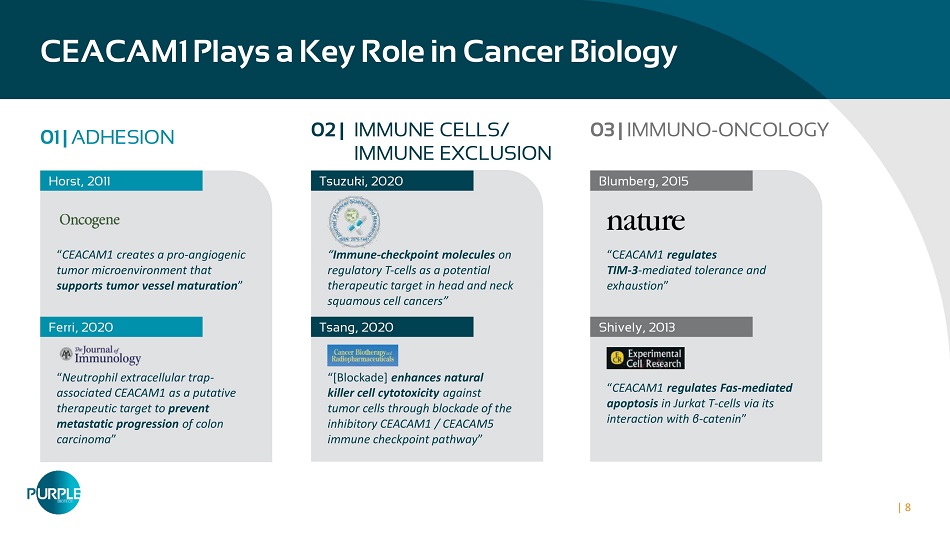
CEACAM1 Plays a Key Role in Cancer Biology 01 | ADHESION Horst, 2011 “ CEACAM1 creates a pro - angiogenic tumor microenvironment that supports tumor vessel maturation ” “ Neutrophil extracellular trap - associated CEACAM1 as a putative therapeutic target to prevent metastatic progression of colon carcinoma ” Ferri, 2020 Tsuzuki, 2020 Tsang, 2020 Blumberg, 2015 “C EACAM1 regulates TIM - 3 - mediated tolerance and exhaustion ” “ CEACAM1 regulates Fas - mediated apoptosis in Jurkat T - cells via its interaction with β - catenin ” Shively, 2013 02 | IMMUNE CELLS/ IMMUNE EXCLUSION 03 | IMMUNO - ONCOLOGY “ Immune-checkpoint molecules on regulatory T-cells as a potential therapeutic target in head and neck squamous cell cancers” “[Blockade] enhances natural killer cell cytotoxicity against tumor cells through blockade of the inhibitory CEACAM1 / CEACAM5 immune checkpoint pathway ” | 8

| 9 CM24 MOA | Immuno - Oncology & Adhesion Markel et al, J Immunol 2002, 2006; Immunology, 2008; Cancer Immunol Immunother 2010; Ortenberg et al, Mol Cancer Ther 2012; Zhou, 2009; Li, 2013; Huang, 2015; Acharya N, et al. J Immunotherapy Canc 8:e911 - 22, 2020.; Rayes RF, et al. Neutrophil Extracellular Trap - Associated CEACAM1 as a Putative Therapeutic Target to Prevent Metastatic Progression of Colon Carcinoma. J Immunol. 2020; Gerstel, D. et al. CEACAM1 creates a pro - angiogenic tumor microenvironment that supports tumor vessel maturation. Oncogene 30, 4275 – 4288 (2011) Tumor CD8+T & NK Cells CEACAM1 CEACAM1 CEACAM1 CEACAM5 Activation of enhanced cytotoxic activity & cytokine production Neutrophil extracellular trap - associated CEACAM1 as a putative therapeutic target to prevent metastatic progression: Primary Tumor Metastasizing CM2 4 Metastatic Tumor
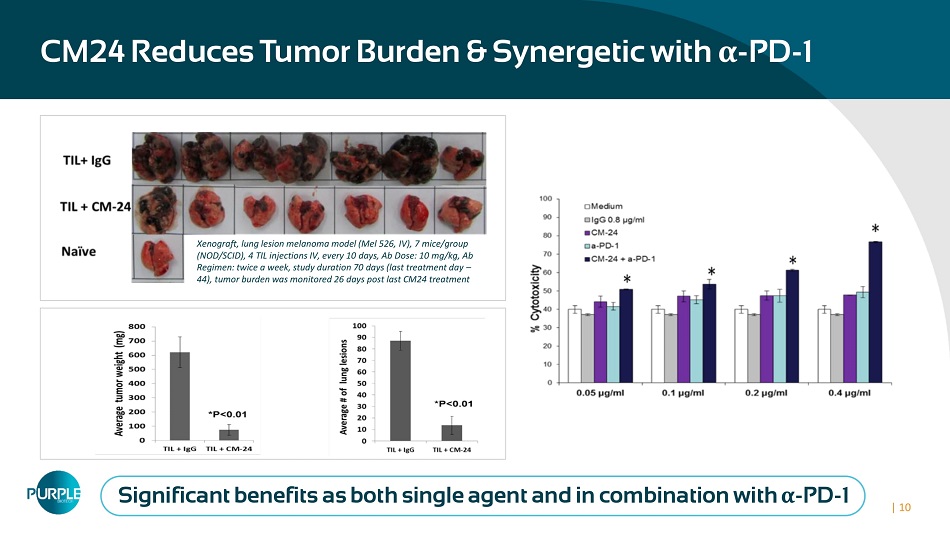
CM24 Reduces Tumor Burden & Synergetic with α - PD - 1 Xenograft, lung lesion melanoma model (Mel 526, IV), 7 mice/group (NOD/SCID), 4 TIL injections IV, every 10 days, Ab Dose: 10 mg/kg, Ab Regimen: twice a week, study duration 70 days (last treatment day – 44), tumor burden was monitored 26 days post last CM24 treatment Significant benefits as both single agent and in combination with α - PD - 1 | 10
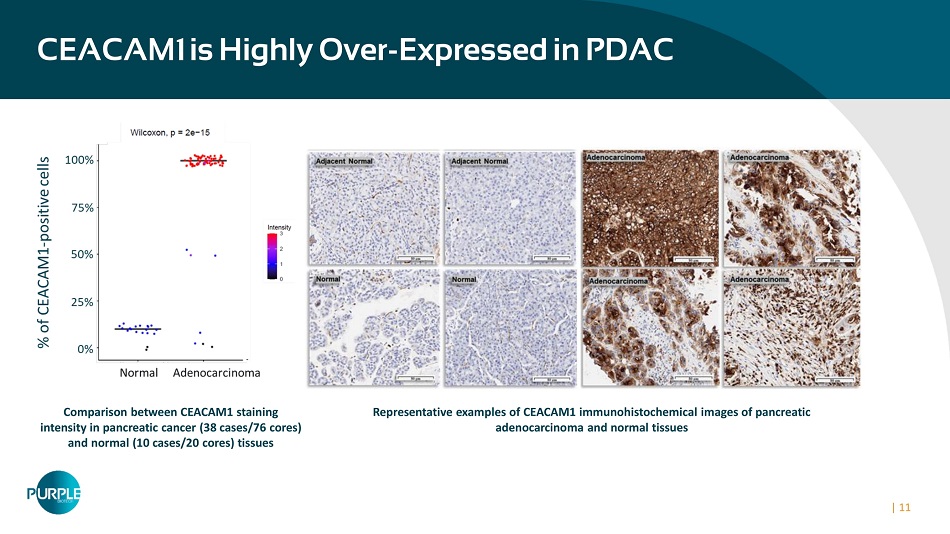
Representative examples of CEACAM1 immunohistochemical images of pancreatic adenocarcinoma and normal tissues Comparison between CEACAM1 staining intensity in pancreatic cancer (38 cases/76 cores) and normal (10 cases/20 cores) tissues CEACAM1 is Highly Over - Expressed in PDAC | 11

Phase 1 Dose Escalation Interim Results CM24 is Safe and Well Tolerated in Combination with Nivolumab AE Term Total 1 Grade 2 3 4/5 Diarrhea 5 4 1 Abdominal pain 4 1 3 Fever 4 2 2 Headache 4 3 1 Fatigue 4 4 Nausea 3 1 2 Creatinine increased 3 2 1 Hypokalemia 2 2 Dyspnea 2 1 1 Constipation 2 2 Cough 2 2 Abdominal pain aggravated 1 1 Alkaline phosphatase increase 1 1 Atrial flutter 1 1 C - Diff Colitis 1 1 GI bleed 1 1 Leukocytosis 1 1 Small bowel obstruction 1 1 Study design • As of March 8 th , 2022, a total of 13 patients were enrolled and 11 patients were evaluable for DLT determination (8 PDAC, 2 CRC and 1 PTC). • 9 patients had received 2 prior regimens for metastatic disease, 2 patients had one previous line. Phase 1 Doses: 10, 15, 20mg/kg q2wk + nivolumab (480mg q4w) 3+3 design, n=12 Indications: Pancreatic, CRC, Papillary Thyroid Carcinoma Phase 2 Expansion cohorts Safety • No DLTs were observed across all dose levels; no Grade 4 AEs or treatment - related deaths have been reported. • Grade 3 AEs were noted in 6/13 patients (46%). | 12

CM24 Phase 1 Dose Escalation Interim Results (cont.) Sustained Clinical Benefit Even After Treatment Cessation For the 11 evaluable patients as of March 8th, 2022, best overall response included 1 confirmed PR (PDAC patient ) 3 SD (2 PDAC and 1 PTC) for a disease control rate of 36% • 9/11 of the evaluable patients are in study follow - up • Pharmacokinetic analysis of CM24 shows exposure is dose - proportional across the 3 doses in this study with a complete receptor occupancy of peripheral CEACAM1 receptors on T cells and neutrophils at CM24 doses of 15 or 20mg/kg • Median overall survival has not yet been reached The Phase 2 portions of the study have been initiated at the conclusion of this dose - escalation part. Overall Survival | 13
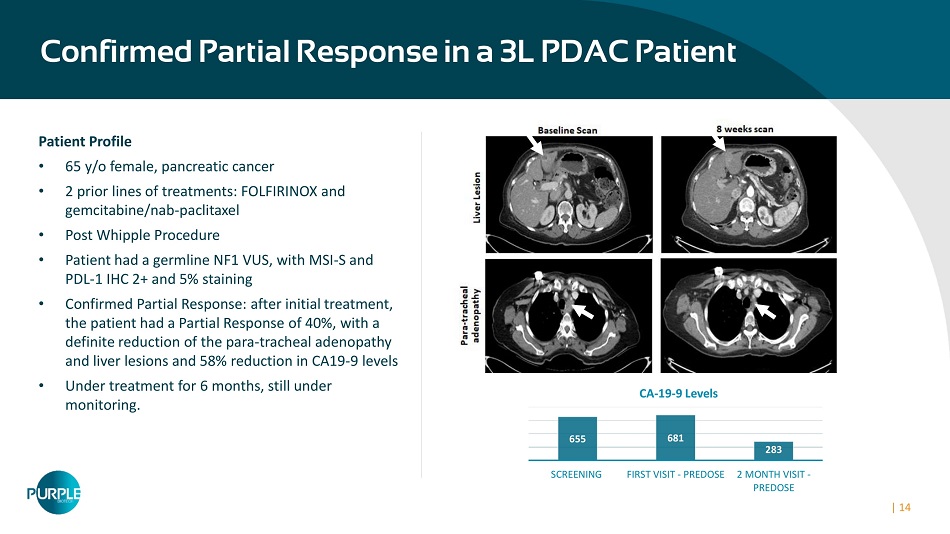
Confirmed Partial Response in a 3L PDAC Patient Patient Profile • 65 y/o female, pancreatic cancer • 2 prior lines of treatments: FOLFIRINOX and gemcitabine/nab - paclitaxel • Post Whipple Procedure • Patient had a germline NF1 VUS, with MSI - S and PDL - 1 IHC 2+ and 5% staining • Confirmed Partial Response: after initial treatment, the patient had a Partial Response of 40%, with a definite reduction of the para - tracheal adenopathy and liver lesions and 58% reduction in CA19 - 9 levels • Under treatment for 6 months, still under monitoring. 655 681 283 SCREENING FIRST VISIT - PREDOSE 2 MONTH VISIT - PREDOSE CA - 19 - 9 Levels | 14

| 15 Large Market Opportunity in Pancreatic Cancer • Pancreatic Cancer accounts for ~60K new cases/year in the US; with a 5 - year relative survival rate of 10% 1 • I/O approaches have been limited to patients with high microsatellite instability (MSI - H) or high tumor mutational burden (TMB - H) • 5 - year overall survival rate with chemotherapy in 2L is 3% 1 • CEACAM1 expression correlates with poor prognosis in Pancreatic cancer 2 • Preclinical data support significant synergy Combining nivolumab with CM24 in a clinical collaboration with Bristol Myers Squibb 1 American Cancer Society, Cancer Facts & Figures 2019, and the ACS website, https://seer.cancer.gov/statfacts/html/pancreas.html 2 Calinescu et al, Journal of Immunology Research 2018: 7169081; Carcinoembryonic antigen - related cell adhesion molecules (CEACAM) 1, 5 and 6 as biomarkers in pancreatic cancer, DOI: 10.1371/journal.pone.0113023

| 16 CM24 Phase 2 Combination Study Design (NCT04731467) A Phase 2 open - label multicenter study of CM 24 in combination with : • Nivolumab and 5 - fluorouracil and liposomal irinotecan or nab - paclitaxel in 2 L pancreatic cancer • 9 centers are currently active in US, EU and IL Measurement of CEACAM1 based bio - marker Planning of further studies in other tumor types is ongoing CM24 (20mg) + SOC Undisclosed indication CM24 (20mg) q2w + nivolumab (480mg) q4w + nal - IRI + 5 - FU/LV or nab - paclitaxel Locally advanced, unresectable pancreatic cancer; 2 nd line n=18+16 (Simon 2 Stage Design) 2022 2023 2024 Primary efficacy endpoint: ORR Secondary endpoints: DCR, DoR, TTR and PFS

Advancing First - in - Class Oncology Therapies NT219: A Small Molecule Dual Inhibitor of IRS 1/2 and STAT3
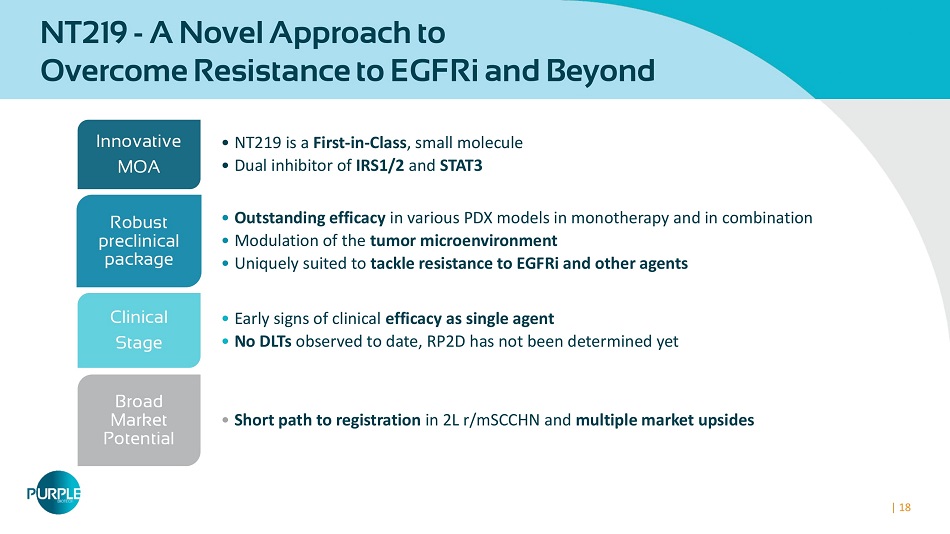
| 18 NT219 - A Novel Approach to Overcome Resistance to EGFRi and Beyond • NT219 is a First - in - Class , small molecule • Dual inhibitor of IRS1/2 and STAT3 Innovative MOA • Outstanding efficacy in various PDX models in monotherapy and in combination • Modulation of the tumor microenvironment • Uniquely suited to tackle resistance to EGFRi and other agents Robust preclinical package • Early signs of clinical efficacy as single agent • No DLTs observed to date, RP2D has not been determined yet Clinical Stage • Short path to registration in 2L r/mSCCHN and multiple market upsides Broad Market Potential

| 19 NT219 - Dual Inhibitor of IRS1/2 & STAT3 NT219 IRS1/2 • Scaffold proteins, mediating mitogenic, metastatic, angiogenic and anti - apoptotic signals from IGF1R, IR, IL4R and other oncogenes, overexpressed in multiple tumors • Regulates major survival pathways such as the PI3K/AKT, MEK/ERK and WNT/β - catenin • Activated as a feedback response to anti - cancer therapies • IRS plays an important role in promoting a tumor - protective microenvironment, by mediating upregulation of TAMs and CAFs STAT3 • Well - established transcription factor associated with the tumorigenic phenotype • STAT3 is broadly hyperactivated in many cancers, promoting proliferation, survival, angiogenesis and metastasis • STAT3 pathway is required for TGFβ - induced EMT and cancer cell migration and invasion • STAT 3 is a critical player in tumor immune evasion, suppressing immune stimulators and enhancing immunosuppressive factors 1 Hadas Reuveni et al. Cancer Res 2013;73:4383 - 4394 ; 2 Machado - Neto et al. Clinics 2018; 73,suppl 1 e566s ; 3 Naokazu Ibuki, Mazyar Ghaffari, Hadas Reuveni et al. Mol Cancer Ther. 2014; 13(12): 2827 - 2839 ; 4 Rampias et al. Oncogene 2016; 35(20):2562 - 4 ; 5 Flashner - Abramson, Reuveni Hadas, Levitzki Alexander et al. Oncogene 2016;35(20):2675 - 80 ; 6 Sanchez - Lopez et al. Oncogene 2016;35(20):2634 - 44 . 7 Zhao C et al. Trends Pharmacol Sci. 2016;37(1):47 - 6; 8 Johnson, Daniel E et al. Nature reviews. Clinical oncology 2018; 15(4): 234 - 248 . 9 Zi Ying et al. J Cell Biochem. 2018;119:9419 - 9432.

Novel MOA: IRS Degradation By NT219 Blocking IGF1R - AKT Pathway 1 Binding to IRS 1 1 Reuveni et al. Cancer Res 2013 ; Ibuki et al. Mol Cancer Ther 2014 2 Ser - phosphorylation Degradation 3 Covalent binding to IRS1/2 leads to the dissociation of IRS1/2 from IGF1R Serine phosphorylation prevents re - binding of IRS1/2 to the receptor CANCER CELL SURVIVAL CANCER CELL APOPTOSIS The proteasome degrades IRS1/2 IGF1 IGF1R IRS AKT PI3K IGF1 IGF1R IRS NT AKT IGF1 IGF1R IRS pS pS AKT IGF1 IGF1R AKT | 20

Novel MOA: Signal Transducer and Activator of Transcription 3 (STAT3) Inhibition • Point of convergence for numerous oncogenic signaling pathways • Central in regulating the anti - tumor immune response • Broadly hyperactivated both in cancer and non - cancerous cells within the tumor ecosystem and plays important roles in inhibiting the expression of crucial immune activation regulators and promoting the production of immunosuppressive factors • Targeting the STAT3 signaling pathway has emerged as a promising therapeutic strategy for numerous cancers NT219 demonstrates a durable and dose - dependent suppression of STAT3 tyrosine phosphorylation, affecting both the tumor cells and the tumor microenvironment. | 21

| 22 Simultaneous blockade of STAT3 and AKT Pathways are Required to Overcome Resistance to EGFRi Overcoming drug resistance NT219 NT219 STAT3 IRS EGFR EGFRi MEK / ERK TUMOR REGRESSION Proof of Concept: PDX model of Head and Neck Cancer Control (n=6) Erlotinib (n=8) Erlotinib+NT219 (n=6) Erlotinib+Ruxolitinib (n=6) Erlotinib+Buparlisib (n=6) Erlotinib+Ruxolitinib+Buparlisib (n=8) STAT3 IRS EGFR MEK Tumor Regression ERK PI3K AKT Tumor Survival Tumor Survival Buparlisib Ruxolitinib Erlotinib NT219 NT219 JAK By blocking both STAT3 and IRS resistance pathways, NT219 prevents tumor resistance and re - sensitizes tumors to anti - cancer therapies
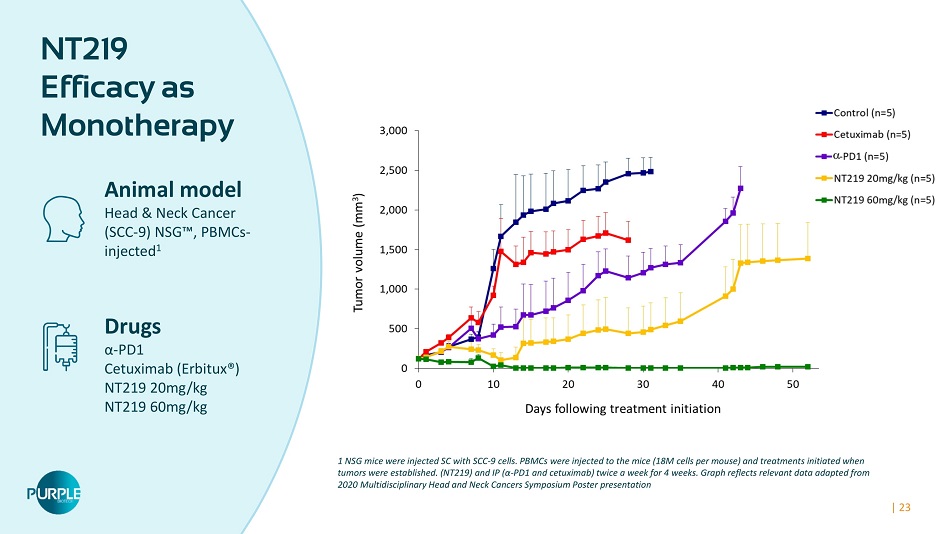
NT219 Efficacy as Monotherapy Animal model Head & Neck Cancer (SCC - 9) NSG Ρ , PBMCs - injected 1 Drugs α - PD1 Cetuximab (Erbitux®) NT219 20mg/kg NT219 60mg/kg 1 NSG mice were injected SC with SCC - 9 cells. PBMCs were injected to the mice (18M cells per mouse) and treatments initiated when tumors were established. (NT219) and IP (α - PD1 and cetuximab) twice a week for 4 weeks. Graph reflects relevant data adapted from 2020 Multidisciplinary Head and Neck Cancers Symposium Poster presentation | 23

Treatments on days 0, 3 and 10, cetuximab - 1mg/mouse, 3 mice/group; PBMCs (1.4M cells/mouse) were injected on day 6 0 Control NT219 Osimertinib Osimertinib+NT219 Osimertinib 5 mg/kg, NT219 65 mg/kg, mean tumor volume at the end point, 3 mice/group; 500 1,000 1,500 2,000 Tumor Volume (mm 3 ) * ** ** * Tumor Volume (mm 3 ) ** p<0.01, * p<0.02 based on one - way ANOVA with post hoc Tukey’s HSD test Control NT219 Cetuximab Cetuximab+NT219 NT219 Restores Sensitivity to EGFRi in PDX Models NSCLC Exon 19 deletion EGFR and T790M, biopsy of bone marrow metastasis, patient previously progressed on afatinib and osimertinib R/M SCCHN metastasis, patient previously progressed on chemoradiation, several chemotherapies, and pembrolizumab | 24

0 200 400 600 800 1000 1200 0 5 10 15 20 Tumor volume (mm3) Days following treatment initiation Control (n=3) NT219 (n=3) Keytruda (n=3) Keytruda + NT219 (n=3) Autologous PBMCs (2.1 M/mouse) NT219 Resensitizes Tumors Refractory to α - PD1 PDX Model Humanized PDX of GastroEsophageal Junction (GEJ) Cancer (refractory to pembrolizumab) Drug Pembrolizumab (Keytruda®) * Double autologous model - Tumors & PBMCs are from the same patient (#RA236) | Keytruda - 6mg/kg IP, NT219 - 60mg/kg IV | 25

NT219 Phase 1 Dose Escalation Monotherapy Interim Results Study design • As of data cutoff date of May 12 th , 2022, a total of 14 patients were enrolled and 12 patients were evaluable for DLT determination (4 CRC, 3 pancreatic cancer, 2 breast cancer, 1 GEJ, 1 esophageal and 1 appendiceal cancer) • Median number of prior treatment regimens for metastatic disease was 4 (2 - 11). AE Term Grade Total 1 2 3 4/5 Fatigue 6 6 Constipation 4 4 ALP increased 3 2 1 ALT increased 3 1 2 Anemia 3 1 2 AST increased 3 1 1 1 Diarrhea 3 2 1 Headache 3 3 Nausea 3 2 1 Abdominal pain 2 1 1 Belching 2 2 Cough 2 2 Dizziness 2 2 Dyspnea 2 2 Edema limbs 2 2 Fever 2 2 Hot flashes 2 2 Hyperhidrosis 2 2 Urinary tract infection 2 2 Abdominopelvic Ascites 1 1 Closed displaced fracture of right femoral neck 1 1 Intractable right hip pain 1 1 Malignant hypercalcemia 1 1 Toxic Encephalopathy 1 1 Worsening back pain 1 1 Abdominopelvic Ascites 1 1 Phase 1 Dose Escalation NT219 q1w (3,6,12,24,50mg/k g) 15 ≤ n ≤ 24 Phase 1/2 combination with cetuximab (Dose Escalation and Expansion) Safety • No DLTs were observed across all dose levels. • Nine Grade 3 adverse events (AEs) were observed, two of which possibly related to NT219 | 26

NT219 Phase 1 Dose Escalation Monotherapy Interim Results: Encouraging Initial Efficacy Signals: • For the 12 evaluable patients, best overall response included one confirmed PR (GEJ patient, > 5.5 months duration of response following end of treatment), and 3 SD with one patient awaiting follow up MRI/CT scans • As of the cutoff date (May 12 th , 2022 ), 10 / 12 patients are either on treatment or in follow up (range 1 . 1 to 18 months) . BOR Cancer Type (prior line) Durable PR in a GEJ patient and SDs in 3/4 mutated KRAS CRC patients | 27
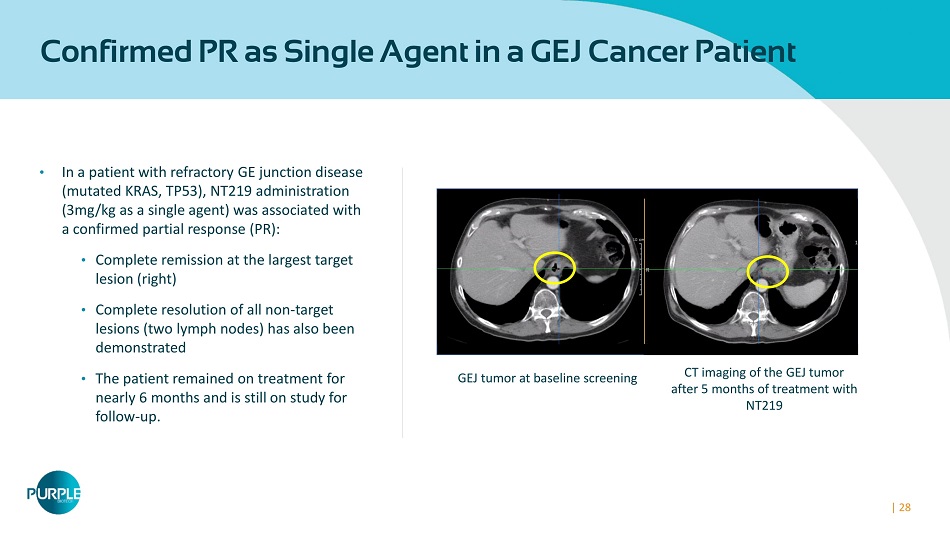
Confirmed PR as Single Agent in a GEJ Cancer Patient • In a patient with refractory GE junction disease (mutated KRAS, TP53), NT219 administration (3mg/kg as a single agent) was associated with a confirmed partial response (PR): • Complete remission at the largest target lesion (right) • Complete resolution of all non - target lesions (two lymph nodes) has also been demonstrated • The patient remained on treatment for nearly 6 months and is still on study for follow - up . Baseline scan 24 weeks scan CT imaging of the GEJ tumor after 5 months of treatment with NT219 GEJ tumor at baseline screening | 28

| 29 First Market Opportunity Recurrent or Metastatic Squamous Cell Carcinoma of Head and Neck (SCCHN) Global Data 2018: Head and Neck Squamous Cell Carcinoma: Opportunity Analysis and Forecasts to 2026 ; Internal best current estimates of patient numbers based on external research, 5 major global territories Rationale for combining Cetuximab + NT219 • EGFR and PD(L) - 1 are the only clinically validated targets in SCCHN • < 15% of R/M SCCHN patients respond to Cetuximab • Cetuximab inhibits EGFR signaling and promotes ADCC in EGFR expressing tumors • STAT3 and IRS - to - AKT activation contributes to resistance to cetuximab in SCCHN Targeting the unmet medical need • 1L Standard of care has shifted from chemotherapy towards immuno - oncology + chemotherapy • < 20% of R/M SCCHN patients respond to Pembrolizumab • SCCHN is the 6 th most common cancer type ; 175k new cases/year are expected by 2024 • Market size forecasted to >$5b in 2030 α - PD - 1 + Chemo 1L 60K pts Cetuximab 2L 37K pts NT219 NT219 + Cetuximab has the potential to become the SOC in 2L r/m SCCHN
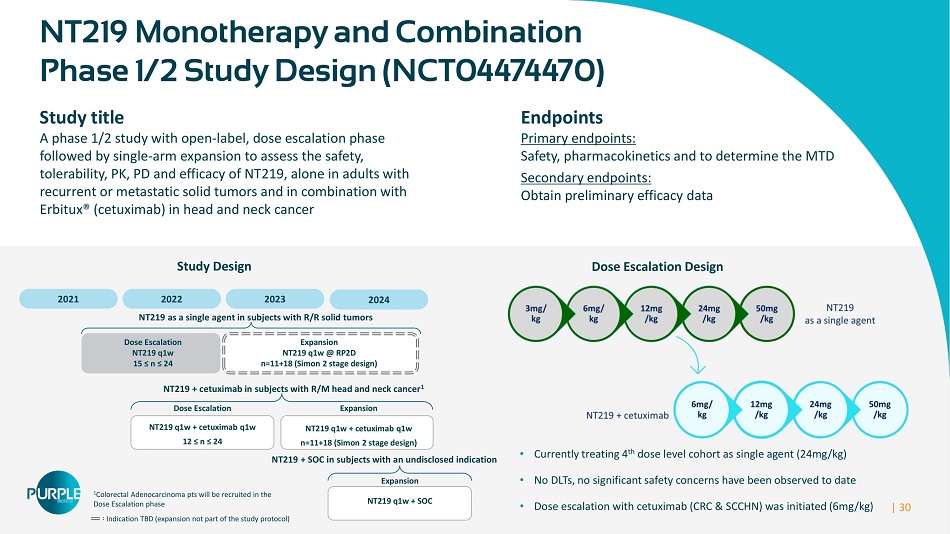
| 30 NT219 Monotherapy and Combination Phase 1/2 Study Design (NCT04474470) Study title A phase 1/2 study with open - label, dose escalation phase followed by single - arm expansion to assess the safety, tolerability, PK, PD and efficacy of NT219, alone in adults with recurrent or metastatic solid tumors and in combination with Erbitux® (cetuximab) in head and neck cancer Endpoints Primary endpoints: Safety, pharmacokinetics and to determine the MTD Secondary endpoints: Obtain preliminary efficacy data 1 Colorectal Adenocarcinoma pts will be recruited in the Dose Escalation phase Indication TBD (expansion not part of the study protocol) 2021 Dose Escalation NT219 q1w 15 ≤ n ≤ 24 Expansion NT219 q1w @ RP2D n=11+18 (Simon 2 stage design) NT219 q1w + cetuximab q1w 12 ≤ n ≤ 24 NT219 + cetuximab in subjects with R/M head and neck cancer 1 Dose Escalation Expansion NT219 q1w + cetuximab q1w n=11+18 (Simon 2 stage design) Dose Escalation Design Study Design NT219 + SOC in subjects with an undisclosed indication Expansion NT219 q1w + SOC • Currently treating 4 th dose level cohort as single agent (24mg/kg) • No DLTs, no significant safety concerns have been observed to date • Dose escalation with cetuximab (CRC & SCCHN) was initiated (6mg/kg) 2022 2023 2024 NT219 as a single agent in subjects with R/R solid tumors

| 31 Business Highlights Strong balance sheet and cash position Purple Biotech (NASDAQ/TASE: PPBT) $42.2M cash as of March 31 st , 2022 ADSs outstanding: 17.8M Multiple data read - outs expected in the next 12 months • Two first - in - class drug candidates • Multiple Phase II studies ongoing and planned • Lean & global operation • BD activity to grow our pipeline with innovative assets • Extended cash runway to end of 2024 We are a clinical - stage company committed to the development of first - in - class, effective therapies by harnessing the power of the tumor microenvironment (TME) to overcome drug resistance and improve treatment outcomes for cancer patients

| 32 We are committed to provide cancer patients with first - in - class therapies to OVERCOME tumor drug resistance, ENHANCE treatment response and SLOW tumor progression Contact Us: ir@purple - biotech.com THANK YOU

Appendix A | CM24

| 34 PK/PD Modeling Provides Dosage & Schedule Guidance Simulated TMDD 1 saturation at Ctrough 2 with Q2W regimen • CM24 completed Phase 1 monotherapy open - label, dose - escalation study to assess safety and tolerability • Heavily pre - treated 24 evaluable patients with a median of 4 prior regimens • Overall, treatment was well tolerated, no DLTs • 33% SD (RECIST 1.0), mostly at the highest dose levels of 3mg/kg & 10mg/kg • PK analysis revealed non - linearity, modeling recommended continuing administration of higher doses to reach saturation, consistent with observed PK showing high clearance at doses <10 mg/kg • 10 mg/kg has a broad range of saturation • Q2W regimen preferable to Q3W 1 Target - mediated drug disposition. 2 Ctrough is the drug concentration reached by CM24 before the next dose is administered Predictions with Q3W regimen

| 35 CM24 Phase 1 Combination Study (NCT04731467) Demographics In the Phase 1 part, patients with indicated refractory cancers were administered CM24 at 10, 15, and 20mg/kg q2w and nivolumab 480mg q4w. • The primary objective of this part was to evaluate safety, tolerability, pharmacokinetics and determine the RP2D • Safety was assessed according to CTCAE v5 and preliminary anti - tumor activity was assessed by the investigators according to RECISTv1.1 using CT/MRI • CM24 and CEACAM1 measurements in serum, biopsy specimens, and TILs, as well as tumor and TILs PD - L1 levels are being determined As of March 8th, 2022, a total of 13 patients were enrolled and 11 patients were evaluable for dose - limiting toxicity (DLT) determination (8 PDAC, 2 CRC and 1 PTC) • 9 patients had received 2 prior regimens for metastatic disease and 2 patients had one previous line. Race, n (%) Diagnosis months (range) 23 (11 - 73) White 10 (91%) ECOG, n (%) Black or African American 1 (9%) 0 7 (64%) 1 4 (36%) Demographics of patients treated with CM24 (10, 15, 20mg/kg) in combination with nivolumab (480mg) Median age, years (range) 65 (49 - 76) Prior Lines of Therapy, n (%) Sex, n (%) 1 2 (18%) Male 5 (45%) 2 9 (82%) Female 6 (55%) Diagnosis , n (%) Ethnicity, n (%) Pancreatic cancer 8 (73%) Not Hispanic or Latino 10 (91%) Papillary Thyroid cancer 1 (9%) Hispanic or Latino 1 (9%) Colorectal cancer 2 (18%) Median Time from Initial

Appendix B | NT219

Selected Publications Michael Karin Alexander Levitzki Menashe Bar - Eli Michael Cox | 37

Colon cancer LS - 513 cells overexpressing IRS2 demonstrate enhanced - catenin activity. Targeted inhibition of IRS2 by NT219 or IRS2 - SH RNA, suppresses the increased - catenin activity and inhibit LS - 513 cell viability. Combination of 5 - FU and NT219 significantly inhibited the growth of CRC tumors in brain, using intracranial model and extended mice survival. AACR Annual Meeting, April 2021, AACR Virtual Special Conference on Epigenetics and Metabolism, Oct 2020, Ido Wolf, MD, Head of Oncology Division, Tel Aviv Sourasky Medical Center IRS2 Active β - Catenin β - actin NT219 - + CRC Cell Viability (72hr) NT219 concentrations ( M) 0.5 1.0 1.5 *** ** DMEM iAKT Alpelisib NT - 219 IRS2 NT219 downregulates IRS2 and suppresses the - catenin activity Silencing IRS2 inhibits - catenin activity NT219 | Suppresses β - Catenin activity in CRC Cells and Inhibited CRC Brain Metastasis 5 - FU NT219 + 5 - FU In Vitro | 38 In Vivo

PDX model Pancreatic Cancer Drug Gemcitabine (Gemzar ® ) NT219 | Pancreatic Cancer in Combination with Gemcitabine | 39 Highly effective anti cancer activity exhibited by NT219 in combination with Gemcitabine

PDX model Pancreatic Cancer Drug Gemcitabine (Gemzar®) RNA Sequencing | Analysis of Tumors Following Treatment Reduced expression of IRS1, Ki67, FOXM1 & TGFb is exhibited by pancreatic cancer treated with NT219 alone and in combination with gemcitabine | 40

NT219 Phase 1 Dose Escalation Monotherapy Demographics As of data cutoff date of May 12th , 2022, a total of 14 patients were enrolled to 4 NT219 dose levels (3 - 24mg/kg) • 12 patients were evaluable for DLT determination including 4 CRC, 3 pancreatic cancer, 2 breast cancer, and one of each of the following cancers: GEJ, esophageal and appendiceal cancer • Median number of prior treatment regimens for metastatic disease was 4 (2 - 11) Demographics of patients treated with NT219 (3, 6, 12, 24mg/kg) Median age, years (range) 67 (39 - 79) Diagnosis , n (%) Sex, n (%) Pancreatic 3(25%) Male 4(33%) GE Junction 1(8%) Female 8 (67%) Breast 2(17%) Ethnicity, n (%) Colorectal 4(33%) Not Hispanic or Latino 11 (92%) Appendiceal 1(8%) Hispanic or Latino 1 (8%) SCC of the esophagus 1(8%) Race, n (%) Prior Lines of Therapy, n (%) White 10 (83%) 2 2 (17%) Black or African American 2 (17%) 3 3 (25%) ECOG, n (%) 4 2(17%) 0 5 (42%) 5 2(17%) 1 7 (58%) 6 1(8%) Median Time from Initial Diagnosis months (range) 36(10 - 153) 8 1(8%) 11 1(8%) | 41